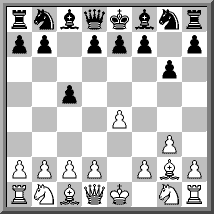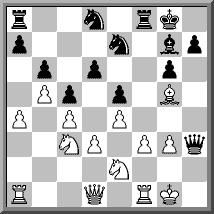Now Lakdawala recommends 3.c3 in order to reach the London safely, and that may also be the best attempt for those hoping for something related to the Torre. For Colle players, 3.e3 is the obvious choice. Unfortunately it's less clear that this will give White an edge than the Nimzo move-order 1.d4 Nf6 2.Nf3 e6 3.e3 - after all Black hasn't blocked his light-squared bishop.
However, none of these moves appears particularly threathening to Black's opening. It could be argued that Black is too optimistic trying to take on White's role in the early phase of the game. If that's the case, White now should play energetically in order to punish Black's arrogance. White's critical moves in the diagram position probably are:
B: 3.c4
C: 3.g3
Let's look a little deeper:
A:
(1.d4 d5 2.Nf3 c5)
3.dxc5
White is playing a reversed Queen's Gambit Accepted. I will not go into much detail here, as this move was the repertoire choice in "A Killer Chess Opening Repertoire". I will only point out one omission and one important alternative for White:
3...e6
3...Nc6?! probably is dubious and wasn't mentioned in the Killer Repertoire. One interesting attempt at refutation is 4.a3 a5 5.Nc3 and now:
a) 5...e6 6.Na4!? seems sufficient to keep the c-pawn.
b) 5...Nf6 6.Bf4 e5 7.Nxe5 Bxc5 8.Nd3 also gave White a safe extra pawn in Bogdanovich-Hubel, Crailsheim 1998.
c) 5...d4 probably is too optimistic: 6.Nb5 e5 7.e3 Bg4 8.Be2 (even stronger may be 8.exd4 exd4 9.Qe2+ Be7 10.Nd6+ Kf8 11.Bf4) 8...Bxf3 9.Bxf3 Bxc5 10.exd4 Bxd4 11.Nxd4 exd4 12.0–0 with an obvious advantage for White in Matlak-Orsag, Karvina 1992.
4.e4!?
This is an important alternative to 4.c4 which was recommended in the Killer Repertoire.
4...Bxc5
It seems White can keep an advantage after 4...Nf6 5.exd5 Qxd5 6.Bd3:
a) 6...Bxc5 7.Nc3 Qd8 8.0–0 Nbd7 9.Bf4 a6 10.Ne4 Nxe4 11.Bxe4 Nf6 12.Qxd8+ Kxd8 13.Rad1+ += Kharlov-Cifuentes Parada, Leeuwarden 1994.
b) 6...Qxc5 7.Nc3 Nbd7 8.0–0 Be7 9.Be3 Qa5 10.a3 a6 11.Qe2 0–0 12.Rfd1 Qc7 13.Bg5 b6 14.Ne4 Bb7 15.Nxf6+ Bxf6 16.Bxh7+ Kxh7 17.Qd3+ Kg8 18.Qxd7 Qxd7 19.Rxd7 Bxb2 20.Rb1 Bxf3 21.Rxb2 Be4 22.Rxb6 Bxc2 23.Rbb7 += Ki.Georgiev-Seirawan, Brussels 1992.
5.exd5 exd5 (D)
In this fairly typical IQP position it seems chances are roughly even. That doesn't mean it cannot be a good practical choice for a good technician. If White makes it to the endgame, he probably will have something to play for.
5...Qb6 probably is too optimistic: 6.Qe2 Nf6 7.Qb5+ Kf8 8.Qxb6 axb6 9.dxe6 Bxe6 10.Nc3 Nc6 11.Bd3 Nb4 12.0–0 += Ruck-Balog, Hungary 2008.
6.Bb5+ Nc6 7.0–0 Nge7 8.Nbd2 0–0 9.Nb3 Bd6
Also 9...Bb6 seems fine: 10.c3 Bg4 11.Be2 Qd6 12.Nfd4 Bxe2 13.Nxe2 Rad8 14.Bf4 Qf6 15.Qd2 h6 16.Be3 Bxe3 17.Qxe3 Nf5 18.Qd2 d4 = A.Sokolovs-Howell, Germany 1996.
10.c3 Bg4 11.Be2 Re8 12.Nfd4 Bxe2 13.Nxe2 Qc7 14.Ng3 Rad8 15.Re1 Qd7 16.Be3
Chances were equal in P.Nikolic-Leko, Horgen 1994.
B:
(1.d4 d5 2.Nf3 c5)
3.c4
With this move White offers Black to play the Tarrasch Defence.
3... cxd4
Instead the Tarrasch would arise after 3...e6. This old defence has, as far as I know, a sound theoretical standing, but many of the resulting positions are hard to defend against skilled opposition. More independent alternatives are:
Instead the Tarrasch would arise after 3...e6. This old defence has, as far as I know, a sound theoretical standing, but many of the resulting positions are hard to defend against skilled opposition. More independent alternatives are:
a) 3...Nf6 4.cxd5 cxd4 5.Qxd4 Qxd5 6.Nc3 must be a shade better for White. A recent example is Kovalyov-Gomez, Dresden 2008 where Black was close to equality after 6...Qa5 7.Ne5 Nc6 8.Nxc6 bxc6 9.g3 Bb7 10.Qa4 Qxa4 11.Nxa4 c5 12.f3 e6 13.e4.
b) After 3...dxc4 4.d5!? may be critical (4.e3 e6 leads to a quiet line of the Queen's Gambit Accepted). Two recent examples are:
b1) 4...Nf6 5.Nc3 e6 6.e4 exd5 7.exd5 Bd6 8.Bxc4 0–0 9.0–0 Bg4 10.h3 Bh5 11.Bg5 h6 12.Bh4 Nbd7 = Akopian-Shirov, Ohrid 2009.
b2) 4...e6 5.Nc3 exd5 6.Qxd5 Qxd5 7.Nxd5 Bd6 8.Nd2 Ne7 9.Nxc4 Nxd5 10.Nxd6+ Ke7 11.Nxc8+ Rxc8 12.g3 Nb4 13.Bh3 Rd8 14.0–0 N8c6 15.Be3 Leitao-Matsuura, Santos 2007.
4.cxd5 Nf6
Black should avoid 4...Qxd5 5.Nc3, e.g. 5...Qd8 6.Qxd4 Qxd4 7.Nxd4 a6 8.Nd5 Kd8 9.Nb6 Ra7 10.Bf4 Nd7 and now Rybka points out that 11.Ne6+! fxe6 12.Be3 would have been the most efficient, even if White has several ways to a big advantage.
5.Qxd4 Qxd5 6.Nc3 Qxd4 7.Nxd4 a6 (D)
This is typical for what White can expect in this line. The pawn structure is symmetrical but White is somewhat better developed. It seems likely that Black can equalize with some care but White can create some difficulties. One sample continuation is:
8.g3 Bd7 9.Bg2 e5 10.Nb3 Bc6 = Landa-Ovetchkin, Krasnoyarsk 2007.
(1.d4 d5 2.Nf3 c5)
3.g3
This quiet move attempts to play a reversed Gruenfeldt Indian. The only problem is that there is no black knight to exchange on c6, so if White hopes for a genuine Gruenfeldt a tempo up, he has to bide his time.
3...cxd4
3...Nc6 4.Bg2 Nf6 5.0–0 e6 6.a3 b5 7.Bg5 Bb7 8.Nc3 h6 9.Bxf6 gxf6 10.dxc5 Bxc5 11.Nxb5 Qb6 12.Nc3 +/- Young-Akobian, Chicago 2009.
4.Bg2
4.Nxd4 e5 5.Nb3
4...Nf6 5.0–0 (D)
In a sense this is a critical position. Should Black play the obvious developing move 5...Nc6, allowing White to have his desired Reversed Gruenfeldt?
5...Nc6
In a sense this is a critical position. Should Black play the obvious developing move 5...Nc6, allowing White to have his desired Reversed Gruenfeldt?
5...Nc6
This is Black's most popular move but there are alternatives:
a) I don't know why 5...Nbd7!? is untested. Black threatens ...e5, so 6.Nxd4 e5 is natural. Then one possible line is 7.Nb3 Nb6 8.Nc3 Be6 9.f4 with complicated play.
a) I don't know why 5...Nbd7!? is untested. Black threatens ...e5, so 6.Nxd4 e5 is natural. Then one possible line is 7.Nb3 Nb6 8.Nc3 Be6 9.f4 with complicated play.
b) 5...h6 is a bit strange but on second thought it seems useful to avoid the potential Bg5 pin. After 6.b3 g6 7.Bb2 Bg7 8.Nxd4 0–0 9.c4 dxc4 10.bxc4 Qb6 11.Qb3 Na6 12.Nd2 Nd7 13.N2f3 Ndc5 gave equal chances in P.Nikolic-P.H.Nielsen, Wijk aan Zee 2005.
c) 5...g6 is natural. Then 6.Nxd4 Bg7 7.c4 0–0 8.cxd5 Nxd5 9.Nb3 e6 10.Nc3 Nxc3 11.bxc3 Qc7 12.Rb1 with unclear play in Graf-Shomoev, Warsaw 2005 is one sample line.
c) 5...g6 is natural. Then 6.Nxd4 Bg7 7.c4 0–0 8.cxd5 Nxd5 9.Nb3 e6 10.Nc3 Nxc3 11.bxc3 Qc7 12.Rb1 with unclear play in Graf-Shomoev, Warsaw 2005 is one sample line.
6.Nxd4 e6
That's the problem when White tries to play a sharp line with colours reversed. You will usually find that Black opts for a non-critical line which nevertheless gives good chances of equality. White has scored massively after 6... e5 7.Nxc6 bxc6 8. c4, but partly that may be because the white players have very clearly outrated their opponents. One recent and typical example is 8...Be7 9.Nc3 Be6 10.Bg5 e4 11.Qa4 O-O 12.Rad1 Qb6 13.Bxf6 Bxf6 14.cxd5 cxd5 15.Nxd5 Bxd5 16.Rxd5 Qxb2 17.e3 with a very clear advantage to White in Burmakin-Lochte, Bad Wiessee 2008.
7.c4 Bc5 8.Nb3 Be7 9.cxd5 Nxd5 10.Nc3 Nxc3 11.Qxd8+ Bxd8 12.bxc3 Bf6 13.Rb1 Bxc3 14.Ba3 += Romanishin-Salmensuu, Linares 1999.
That's the problem when White tries to play a sharp line with colours reversed. You will usually find that Black opts for a non-critical line which nevertheless gives good chances of equality. White has scored massively after 6... e5 7.Nxc6 bxc6 8. c4, but partly that may be because the white players have very clearly outrated their opponents. One recent and typical example is 8...Be7 9.Nc3 Be6 10.Bg5 e4 11.Qa4 O-O 12.Rad1 Qb6 13.Bxf6 Bxf6 14.cxd5 cxd5 15.Nxd5 Bxd5 16.Rxd5 Qxb2 17.e3 with a very clear advantage to White in Burmakin-Lochte, Bad Wiessee 2008.
7.c4 Bc5 8.Nb3 Be7 9.cxd5 Nxd5 10.Nc3 Nxc3 11.Qxd8+ Bxd8 12.bxc3 Bf6 13.Rb1 Bxc3 14.Ba3 += Romanishin-Salmensuu, Linares 1999.









































